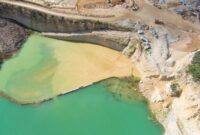Mountain regions offer unique opportunities for investment, particularly in infrastructure development. With natural beauty, resources, and increasing demand for sustainable tourism, investing in mountain infrastructure is becoming a promising venture for forward-thinking investors. However, building in mountainous areas comes with its challenges, including difficult terrain, environmental concerns, and access to resources. In this article, we’ll explore why this investment is crucial for the future, how to overcome the challenges, and how you can capitalize on this growing market.
Why Invest in Mountain Infrastructure?
Mountainous regions are often underdeveloped, which presents significant opportunities for infrastructure development. Building infrastructure such as roads, bridges, water systems, and renewable energy facilities not only supports local communities but also opens doors for economic growth. Investing in mountain infrastructure is not just about enhancing accessibility but also about creating long-term economic benefits through tourism, agriculture, and sustainable development.
Key reasons to consider this type of investment include:
- Tourism potential: Many mountain regions are tourist hotspots, attracting millions of visitors annually. Well-developed infrastructure can significantly boost tourism revenue.
- Sustainable development: Mountain regions are ideal for renewable energy projects, such as hydroelectric dams and wind turbines, making infrastructure investments beneficial for the environment.
- Economic growth: Improving infrastructure creates job opportunities and enhances the quality of life for local communities, contributing to regional economic development.
Overcoming the Challenges of Mountain Infrastructure Development
Developing infrastructure in mountain regions requires overcoming several unique challenges. These include difficult terrain, limited access to materials, environmental concerns, and high costs. Successful investing in mountain infrastructure hinges on addressing these issues strategically.
Difficult Terrain and Construction Costs
Building roads, bridges, and other infrastructure in mountainous areas can be expensive and time-consuming. The rough terrain makes construction more complex, requiring specialized equipment and expertise. Moreover, the cost of transporting materials to remote locations can significantly increase project expenses.
Solutions:
- Employ modern construction techniques such as tunneling and suspension bridges to navigate difficult terrain.
- Utilize local materials where possible to reduce transportation costs.
- Invest in long-term infrastructure maintenance to ensure sustainability and reduce future expenses.
Environmental Concerns
Mountain regions are often home to delicate ecosystems. Infrastructure development can lead to deforestation, loss of biodiversity, and disruption of local wildlife. Therefore, it is crucial to balance development with environmental sustainability.
Solutions:
- Conduct thorough environmental impact assessments before starting any project.
- Use eco-friendly construction materials and techniques to minimize harm to the environment.
- Prioritize renewable energy projects that have a lower environmental footprint.
The Future of Mountain Infrastructure Investment
The future of investing in mountain infrastructure looks promising, especially with advancements in technology and sustainable practices. Governments and private investors alike are recognizing the importance of developing these regions to support economic growth while preserving the environment.
Key trends that will shape future investment opportunities include:
- Green infrastructure: Emphasizing eco-friendly and sustainable development will be a major focus for future projects.
- Technological advancements: Innovations in construction, transportation, and energy generation will reduce the costs and challenges associated with building in mountainous regions.
- Public-private partnerships: Collaboration between governments and private investors will be crucial for financing large-scale infrastructure projects.
Conclusion
Investing in mountain infrastructure offers a unique opportunity to build for the future while supporting sustainable development. Although the challenges of difficult terrain, high costs, and environmental concerns are significant, they can be overcome with strategic planning and innovative solutions. By focusing on green infrastructure, leveraging new technologies, and fostering public-private partnerships, investors can tap into the economic potential of mountain regions while contributing to their long-term sustainability.
FAQ
Q: What types of infrastructure are most important for mountain regions?
A: Key infrastructure types include roads, bridges, renewable energy facilities, water supply systems, and telecommunications networks.
Q: How can investors ensure their projects are environmentally sustainable?
A: Investors should conduct thorough environmental impact assessments, use eco-friendly materials, and prioritize renewable energy projects to minimize environmental damage.
Q: What are the financial benefits of investing in mountain infrastructure?
A: The primary benefits include increased tourism revenue, job creation, and long-term economic growth in underdeveloped regions.
Q: What challenges do investors face when developing infrastructure in mountain areas?
A: The main challenges are difficult terrain, high construction costs, environmental concerns, and limited access to resources.
Q: What is the future outlook for mountain infrastructure investment?
A: The future looks promising, with increasing focus on green infrastructure, technological innovations, and collaborations between public and private sectors.




